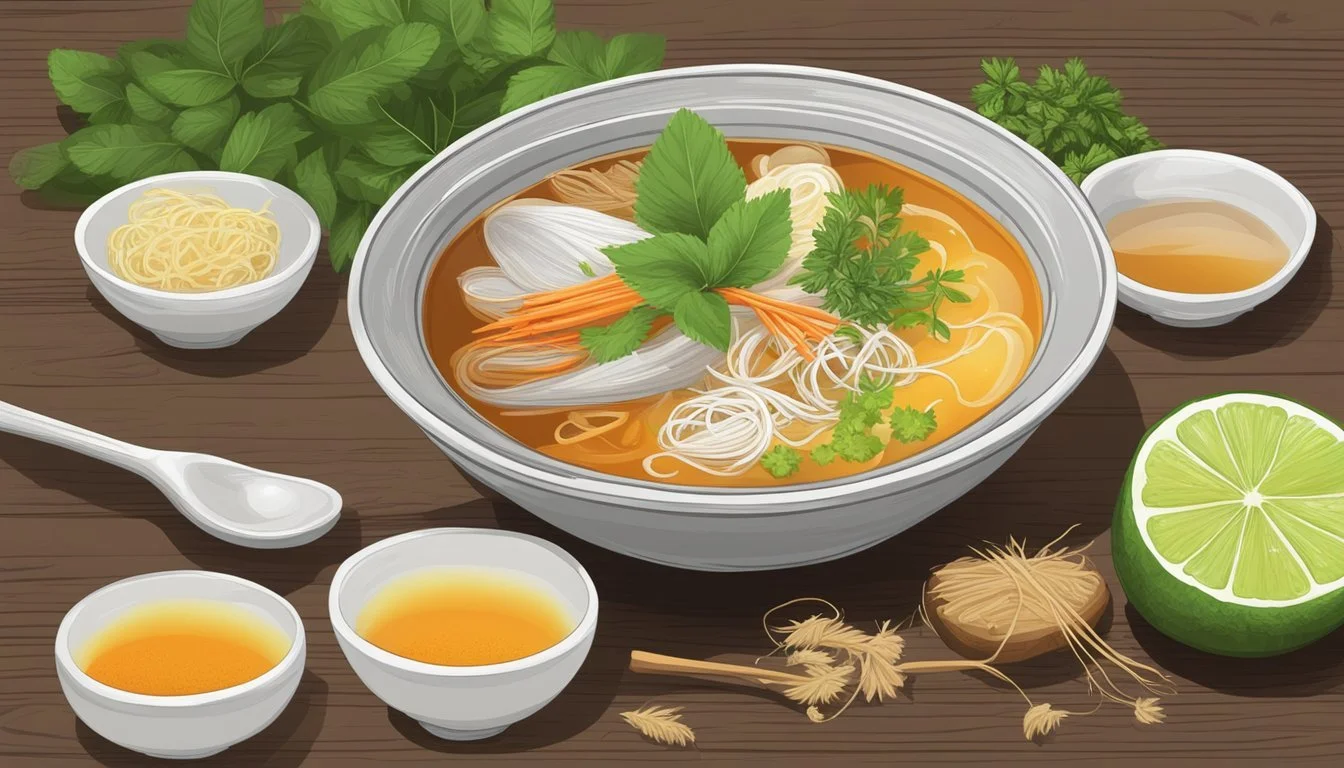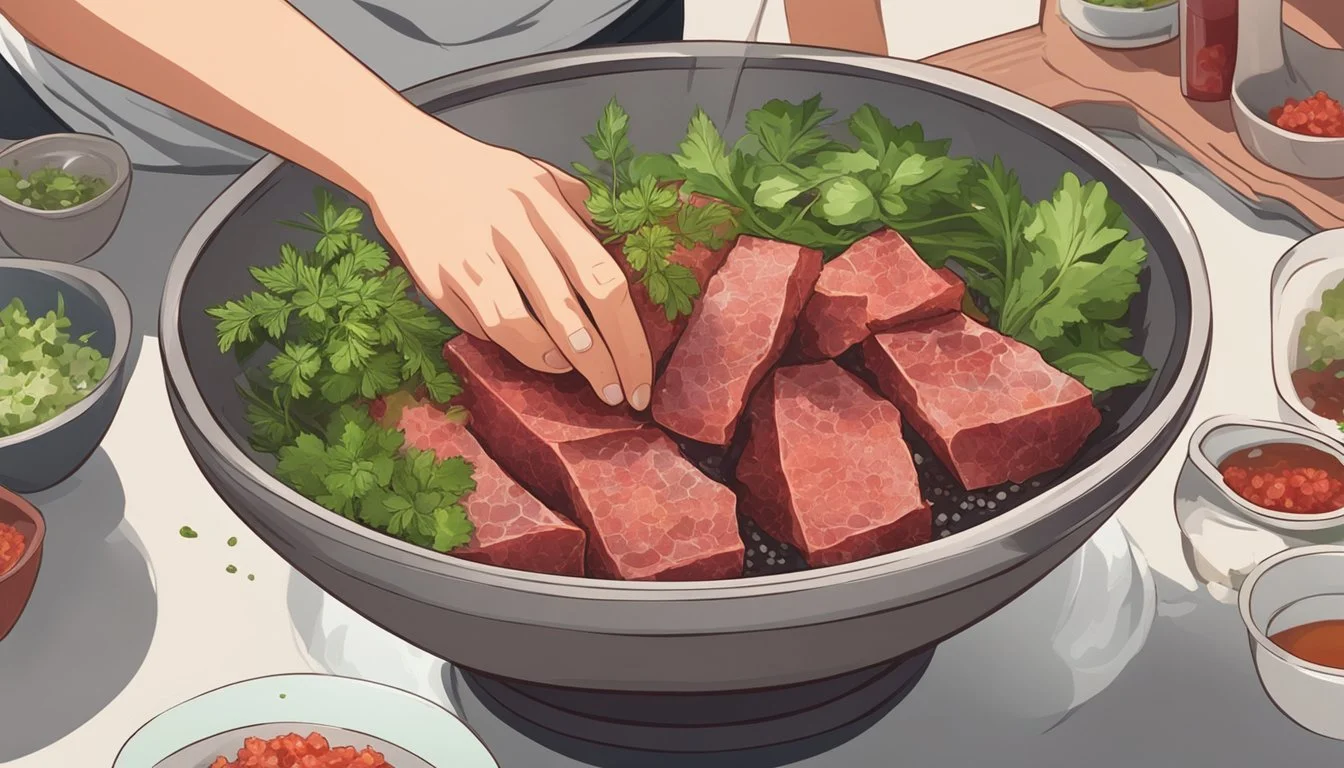Tiet Canh
Unveiling Vietnam's Adventurous Raw Blood Soup Delicacy
Tiet Canh is a traditional Vietnamese dish that has intrigued and challenged culinary enthusiasts and travelers alike. Known colloquially as raw blood soup, this dish is deeply rooted in the food culture of Vietnam, especially prevalent in the northern regions. It is made from raw blood, typically from ducks (What wine goes well with duck?) or pigs, which is mixed with fish sauce and set to a jelly-like consistency. The blood is usually combined with cooked meat and garnished with fresh herbs such as Vietnamese coriander and mint, as well as other toppings like peanuts to enhance texture and flavor.
Serving as more than just a meal, Tiet Canh represents a customary practice in Vietnamese cuisine and is often prepared for special occasions and celebrations. Despite its controversial nature due to health concerns associated with consuming raw blood, this dish continues to hold its place at the Vietnamese table. The traditional preparation methods and the cultural significance of Tiet Canh underscore the diversity and the daring nature of Vietnamese cuisine, which is renowned for its balance of flavors and innovative uses of ingredients.
Historical Context of Tiet Canh
Tiet Canh is a traditional Vietnamese dish whose preparation and consumption are deeply rooted in the country's cultural history, particularly in the North. Its longstanding presence underscores not only a culinary practice but also a complex interplay of culture, tradition, and regional adaptations.
Origins and Cultural Significance
The origins of Tiet Canh date back to ancient times in Vietnam, a country with a rich history in Southeast Asia. This dish embodies a traditional method of Vietnamese cuisine that utilizes every part of an animal, a practice stemming from resourcefulness and respect for food. Tiet Canh is typically made using the fresh blood of ducks or pigs combined with cooked meat and served as a pudding. It carries significant cultural value and is commonly prepared for special occasions and festivities, symbolizing vitality and community bonding.
Regional Variations
In Vietnam, regional differences often give rise to distinct variations of the same dish:
North: In Northern Vietnam, Tiet Canh is traditionally made with duck blood, which is preferred for its flavor and texture.
Central: The Central region of Vietnam, particularly Hue, is known for a more diverse use of ingredients and can include different types of meat in its version of the dish.
South: Although less common than in the North, Tiet Canh is present in the South with a lighter, less intense flavor profile compared to its Northern counterpart.
The adaptations of this dish across various regions of Vietnam highlight the versatility and deep integration of Tiet Canh within Vietnamese food (What wine goes well with Vietnamese food?) culture. Each local rendition reflects unique regional tastes and the adaptability of Vietnamese gastronomy.
Ingredients and Preparation
The preparation of Tiet Canh, a distinctive Vietnamese dish, encompasses several ingredients ranging from protein-rich blood to various herbs and spices. The process is meticulous, aiming to strike a balance between texture and flavor.
Main Components of Tiet Canh
Protein: The foundation of Tiet Canh is the raw blood, typically from ducks or pigs, which coagulates to form the base of the soup. Often, cooked offal is added to enrich the dish with protein and flavor.
Blood Soup Base:
Ducks or pigs' blood: 1 part
Cooked water (to prevent blood from coagulating too quickly): 2 parts
Protein (offal, usually from the same animal providing the blood): Variable amount depending on preference.
Herbs and Spices Used
Herbs: Fresh herbs such as Vietnamese coriander and mint contribute both to the aromatic quality and the fresh, verdant taste of Tiet Canh.
Spices and Seasonings:
Fish sauce: To taste, for umami and saltiness.
Salt: Pinch, to enhance flavor.
Black pepper: Ground, sprinkled as per taste for warmth and complexity.
Process of Making the Raw Blood Soup
The process begins with collecting fresh blood, followed by a careful mixing with lightly salted water to prevent premature coagulation. The cooked meat, typically from the respective animal whose blood is used, is cubed and distributed over a serving dish. The seasoned blood mixture is then poured over the meat and allowed to set into a gelatinous consistency. Before serving, a garnish of chopped peanuts, herbs, and additional spices is added to the dish for extra flavor and crunch. It is essential that this dish is consumed immediately and handled with care due to potential health risks associated with raw blood.
Nutritional and Health Considerations
Tiet Canh is a traditional Vietnamese food with distinct nutritional aspects owing to its unique preparation. It is made typically from raw duck or pig blood, which provides protein and other nutrients. However, there are significant health risks associated with the consumption of raw blood.
Health Benefits and Risks
Health Benefits:
Protein: As a protein-rich dish, Tiet Canh offers essential amino acids necessary for bodily functions.
Iron: The dish contains iron, which is crucial for blood formation and oxygen transport in the body.
Health Risks:
Bacterial Infections: Consuming raw blood can pose a risk of bacterial infections such as salmonella and E. coli.
Parasites: There is also a potential exposure to parasites that can cause serious health issues.
Dietary Context of Tiet Canh
Cultural Significance: In Vietnam, Tiet Canh is considered a delicacy and is culturally significant during certain festivals and celebrations.
Preparatory Methods: Safe preparation methods are paramount. Traditionally, lime juice or fish sauce is added not only for flavor but also to slow down bacterial growth.
Moderation in Diet: Those considering including Tiet Canh in their diet should do so with an understanding of the risks involved and consume it in moderation.
It should be noted that while Tiet Canh offers some nutritional benefits as a source of protein, the health risks associated with consuming raw blood may outweigh the benefits for many individuals. Therefore, careful consideration should be taken by those wishing to try this traditional dish.
Consumption and Serving Suggestions
Tiết Canh is a dish that varies by region and is often accompanied by an array of herbs and side dishes. Its serving is a reflection of Vietnamese culinary tradition, particularly during special occasions.
Traditional Occasions for Serving Tiết Canh
Tiết Canh is typically reserved for special events and gatherings. In Vietnam, it is commonly seen during festive celebrations and family feasts. The dish is considered a delicacy and is often consumed for its supposed health benefits and to honor tradition.
Accompaniments and Side Dishes
To complement Tiết Canh, fresh herbs such as Vietnamese coriander and mint are customary. Additionally, a variety of side dishes may be served:
Noodles: Often rice noodles as a staple in Vietnamese cuisine.
Vegetables: Fresh or pickled vegetables (What wine goes well with pickled vegetables?) to balance the rich flavors.
Fish Sauce: A splash of fish sauce for an umami kick.
These elements together ensure a balanced taste and authentic Vietnamese dining experience.
Modern Takes on Tiết Canh
Innovations in Vietnamese culinary practices have led to variations of Tiết Canh that address health concerns, with some versions omitting the raw blood element. These modern interpretations may use beetroot juice or agar powder to mimic the traditional appearance of the dish while eliminating the risks associated with consuming raw blood. Such adaptations make it more suitable for wider audiences and allow it to be enjoyed in a safer manner.
Contemporary Discussions
In recent years, discussions about Tiet Canh have focused on issues of food safety and the dish's evolving role in Vietnamese cuisine. These conversations reflect the broader tensions between traditional practices and modern health standards.
Food Safety and Tiet Canh
Tiet Canh has come under scrutiny due to concerns over foodborne illnesses. The dish consists largely of raw blood, typically from ducks or pigs, and its preparation lacks the heat treatment that eliminates pathogens. In Asia, particularly in Vietnam, public health authorities have underscored the risks associated with consuming raw blood. They point to the potential presence of bacteria like Salmonella and viruses such as the H5N1 avian influenza.
To mitigate these risks, some cooks and food enthusiasts are suggesting modern twists to the traditional recipe. One method includes treating the blood with anticoagulants before serving or substituting animal blood with alternatives such as beetroot juice to mimic the appearance while avoiding the health hazards.
The Future of Tiet Canh in Vietnamese Cuisine
The future of Tiet Canh in Vietnamese cuisine is a subject of much debate. As health awareness rises, traditional practices face new challenges. Factors influencing its future include:
Cultural significance: Retaining the authenticity and cultural heritage of the dish.
Innovation: Adapting and modernizing recipes to meet safety standards without losing essence.
Education: Increasing public knowledge about the risks related to raw blood consumption and safe preparation methods.
Advocates for the dish argue that with proper education on safe preparation methods, Tiet Canh can continue to be enjoyed. At the same time, culinary innovation may lead to new versions of the dish that honor the tradition while ensuring public health.
Culinary Comparison
Tiết Canh is a distinctive element within Vietnamese cuisine and Asian gastronomy at large, offering a bold flavor profile and preparation method that is both intriguing and daunting to many. This dish provides an interesting point of reference for exploring the uniqueness of Southeast Asia's culinary traditions and their intersection with wider global food culture.
Similar Dishes in Other Cuisines
In other Asian cuisines, one might find dishes that use raw or partially cooked blood as a key ingredient, though each with regional twists on preparation and presentation. Korea’s ‘Sundae’ is a kind of blood sausage where blood is cooked with fillers like noodles, while the Laotian 'Larb Leuat Neua' is a salad that includes raw beef and beef blood. These dishes, like Tiết Canh, showcase a traditional approach to utilizing every part of an animal in culinary practices, echoing a philosophy of resourcefulness prevalent in Southeast Asian cuisines.
European cuisines also have their variants; for example, the Spanish ‘Morcilla’ and the British ‘Black Pudding’ are types of blood sausages consumed widely and share the trait of incorporating animal blood, albeit in a cured form compared to the raw state of Tiết Canh.
Tiet Canh’s Place in World Gastronomy
Tiết Canh holds a distinct position in world gastronomy, existing at the intersection of traditional Vietnamese food culture and the broader dynamic tapestry of global food practices. It challenges palates accustomed to more conventional dishes and invites contemplation of diverse culinary norms.
Within Vietnamese Food culture, Tiết Canh is often reserved for special occasions, emphasizing the communal and celebratory aspects of its consumption which can be likened to the consumption of delicacies in other global cultures. However, due to health concerns regarding the consumption of raw blood, the dish's popularity may contrast with trends in global food culture that increasingly lean towards health-consciousness and safety.
In terms of global food culture, Tiết Canh can be a cultural marker for the adventurous eater and a testament to the varied range of textures and flavors that Southeast Asian cuisines bring to the global table. Understanding this dish within the context of Asian Cuisine allows enthusiasts and scholars alike to appreciate the rich diversity and historical underpinnings that make up the global culinary landscape.



